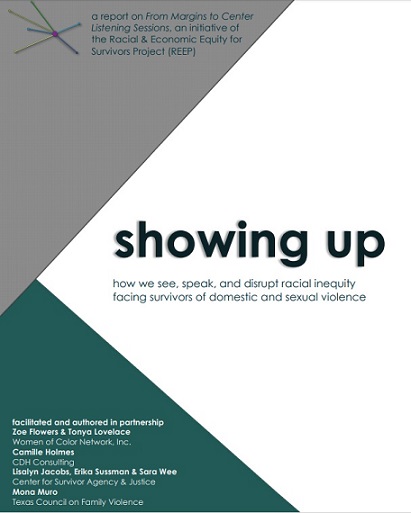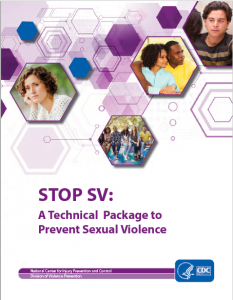Resources Library:
Start a Search:
Showing Up: How We See, Speak, and Disrupt Racial Inequity Facing Survivors

(as originally posted by the Center for Survivor Agency & Justice)
In September 2017, REEP facilitated seven From Margins to Center Listening Sessions to facilitate dialogue across the field on racial and economic equity for survivors. This report dialogues-back with the community that contributed to the From Margins to Center Listening Sessions. It shares themes and issues from Listening Session conversations via text, graphics and illustrations in order to aid in self-reflection, challenge dominant narratives, support improved data collection and analysis, and to begin, continue, or advance conversations and work toward racial equity for domestic and sexual violence survivors and for all of us.
Sisters of Color Ending Sexual Assault
Sisters of Color Ending Sexual Assault - SCESA’s overall fundamental principal is to give voice and develop action strategies that incorporate and address the multiple layers of discrimination that are faced by Women of Color and Communities of Color.
Social Media Policy Guidelines
Many programs, advocates and survivors use social media to connect with friends, family and colleagues. As an emerging technology and one fraught with many privacy risks, many programs are interested in creating policies that help address how their agency, staff, and survivors use social media. Because social media policies should be specific to the agencies’ goals, use, and concerns, a general social media policy template can often be ineffective.
Originally published by the National Network to End Domestic Violence (NNEDV), this guide is intended to help you think through the questions and issues you should consider when developing your social media policy. Keeping in mind that an organization’s use of social media can differ dramatically from an advocates’ use or a survivors’ use, therefore this guide is divided along those lines.
You can also visit their Technology Safety blog for more information on how to safely engage with survivors online.
State Policy Playbook for Ending Campus Sexual Assault
Know Your IX's State Policy Playbook outlines key reforms that students, advocates, and state policymakers can pursue to support survivors on campus, keep students safe, and end gender-based violence in school. Although Title IX and the Clery Act require schools to take action to address gender-based violence, these federal laws set only a floor for schools' responsibilities to create safe and equitable learning environments. States can and should do more to keep schools from sweeping sexual violence under the rug.
For additional resources, you can visit the Know your IX website here.
STOP SV: A Technical Package to Prevent Sexual Violence

This Centers for Disease Control and Prevention technical package represents a select group of strategies based on the best available evidencde to help communities and states sharpen their focus on prevention activities with the greatest potential to reduce sexual violenced and its consequences. Each strategy includes a rationale, specific approaches, potential outcomes, and evidence.

